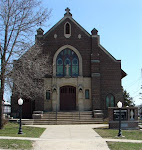There were a few new articles added to the booklet this year and are posted below.
Saturday, March 17, 2012
Second Annual St. Patrick's Dinner
The second annual St. Patrick's Dinner was a success. Thanks to everyone who helped make the dinner a enjoyable event. A special thanks goes to Joe O'Reilly for singing Irish songs.
There were a few new articles added to the booklet this year and are posted below.
Second Annual St. Patrick's Dinner
The pictures were taken by Ken Lee.
There were a few new articles added to the booklet this year and are posted below.
Irish Immigrants in America
written by Pat Thompson
The first big group of poor refugees ever to come to the U.S. were the Irish. Over 650,000 came in the mid-1800’s--first to the big cities on the easter seaboard. In 1847, 37,000 arrived in Boston and 52,000 in New York. There they found such poor living conditions that adult Irish lived only an average of six years after arriving here. In Boston alone, 60% of Irish children died before their sixth birthday. Irish working men earned about 8 cents a day in Ireland. American working men could earn an average of $1.00 a day. Faced with starvation and a desire to better their circumstances, the Irish were willing to work for less. Fearful that the Irish would cause trouble among their workers, businesses soon posted “No Irish Need Apply” signs everywhere. Because most of the Irish were Catholics, Catholicism was on its way to becoming the largest Christian denomination in America, so Protestants, fearing the influence of the Pope, burned down a convent, tow churches and hundreds of Catholic homes in Boston. Three days of rioting between the Irish and the Protestants followed. John Hughes, Archbishop of New York, warned to New York’s mayor that the Irish would burn all of Manhattan if one Catholic church was touched.
Because living conditions were so harsh, jobs so scarce, and tensions so high, the Irish began to migrate west. Many sought jobs in factories, in mines, and with the railroad. “Folklore has it that the verdant, rolling hills of southern Iowa reminded them of home,” so many Irish chose to settle here.
The Irish Potato Famine
written by Pat Thompson
Beginning in 1845 and lasting six years, the Irish potato famine killed over a million Irish and caused another million to flee Ireland.
Potatoes were rich in protein, carbohydrates, minerals and vitamins, so it was possible for even the poor Irish (said to the the poorest people in the western world at that time) to remain healthy on a diet of potatoes. An acre in Ireland (most lived on ten acres or less) could produce up to 12 tons of potatoes, enough to feed a family of six for a year with some left over for animals. Irish farmers planted their potatoes around St. Patrick’s Day, but in September 1845, an airborne fungus transported in the holds of ships traveling form North America to England drifted to Ireland. The leaves on the potato plants suddenly turned black, and the plants fermented, emitting a nauseating stench. Potatoes dug up looked edible at first but within days shriveled and rotted. A single diseased plant could infect thousands in just a few days.
The second year farmers used diseased potatoes from the previous year as seed potatoes. This produced deadly results. That year’s yield was only enough to feed the Irish for one month. Soon people had no food and no money to buy food even if a single loaf of bread or and ounce of corn were available. The oats or grain the Irish were able to grow were sent in boatloads to England so that the absentee landlords would get their yearly profits. The Irish sold or ate their animals and soon were forced to try to survive on blackberries, nettles, old cabbage leaves, seaweed, shellfish, roots and even weeds and grass. What about fish? They were to far out for the little Irish fishing boats to venture.
In the winter of 1846-47, Ireland suffered an unusually harsh winter with one blizzard following another. The cold, together with few jobs, poor wages, and rents they couldn’t pay added to their misery. Britain had finally sent Indian corn and some other food supplies, but the people had no money to buy it. The landlords evicted one half million from their small cottages, often throwing the husbands in jail and the wives and children into the streets. Some landlords--to get rid of the distressing Irish problems--offered to send them to Canada and got them to go by promising them money, food, and clothing upon arrival, promises never kept. Because Irish Catholics were forbidden to hold government office, vote, buy land, practice law, attend school, serve an apprenticeship, possess weapons, or practice their religion and because they were starving, many Irish chose to sail away from their homeland. The ships that transported them came to be called Coffin Ships because one fifth of all their passengers died of disease or malnutrition. Finally they arrived in Canada, and finding it none too welcoming, many chose to walk across the border to the United States, the country that had fought and defeated the British.




